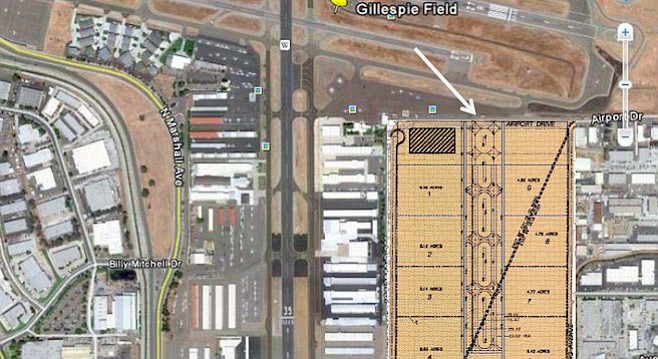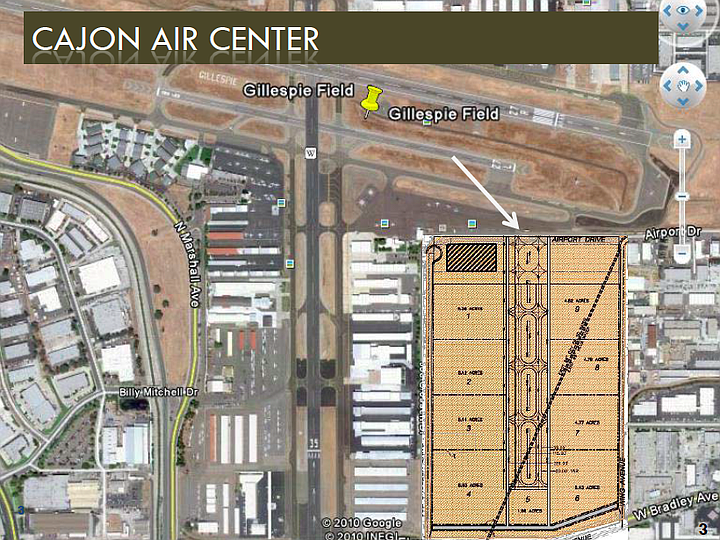 Facebook
Facebook
 X
X
 Instagram
Instagram
 TikTok
TikTok
 Youtube
Youtube

It’s been 11 years since the drone and snarl of race cars was heard around East County’s Cajon Speedway. Now that noise has been replaced by the drone of small aircraft from adjacent Gillespie Field.
The El Cajon airport, owned and operated by San Diego County, has reclaimed the 70 acres on its west side it had leased to the speedway for 50 years. The site also included a golf driving range and a motocross course.
The airport’s redevelopment plans for the proposed Cajon Air Center include a new taxiway and construction of aviation-related businesses on a portion of the land. The County Board of Supervisors approved the final environmental impact report on the Gillespie Field 70-Acre Redevelopment Project, which includes the Cajon Air Center, in 2012.
“Site development will be in phases and is contingent upon [Federal Aviation Administration] funding,” Gillespie Field manager Marc Baskel said in a recent email.
The project has so far received $2.84 million in FAA grants and $292,000 from the airport’s enterprise fund, Baskel said.

But some of Gillespie Field’s neighbors in Santee, Lakeside, and the Fletcher Hills area of El Cajon have concerns, including increased air traffic and noise from low-flying aircraft, as well as possible expansion of the current seven flight schools at the field.
“We are not calling for the closure of Gillespie Field and never have,” said Sue Strom of ASAP (Advocates for Safe Airport Policies), a group of Fletcher Hills residents. “We have always been asking for enforceable rules.”
Strom says her group spent three years “talking to everybody” but received pushback from government officials, some pilots, and the Gillespie Field Development Council. Now the group is ready to file a mass tort suit against the Gillespie Field flight schools and the County of San Diego. The civil action will ask for injunctive relief to reduce the use of highly leaded aviation fuel and monetary compensation for noise remediation, reduced home values, and decreased enjoyment of their homes by the resident plaintiffs.
Decreased enjoyment is important to ASAP member Christopher Dean, a Celtic guitarist who performs professionally and records music in his home studio.
“When I record an acoustic guitar track, I have to do at least five takes to edit out airplane noise,” Dean said.
Dean and his wife bought their Fletcher Hills home in 1990, and he said there were “no issues” until 2005 when he noticed an increase in small planes flying low over their home, some at intervals of three every 60 seconds.
“We have been deprived of what we’ve been guaranteed,” Dean said. “We are unable to enjoy our home.”
However, figures provided by Baskel show the aircraft operation (a takeoff or a landing) number for 2014 was 199,388, down from a high of 300,391 in 2007 and a 51-year average of 218,795.
Safety concerns also include the fact that pilots often fly under radar due to the surrounding mountains. FAA rules call for an altitude of at least 1000 feet over the highest obstacle in a congested area, except for takeoff or landing. The radio control tower at Gillespie Field is open from 7 a.m. to 9 p.m. daily, but there are no curfews on flights.
The airport curfew is voluntary because federal grant assurances don’t allow airport sponsors to restrict access, Baskel said. “However, just because it is voluntary doesn’t mean that aircraft operators don’t treat our voluntary noise abatement procedures as policy,” he said.
Lakeside resident Robert Germann is a founding member and spokesperson for CAGE/LFA (Citizens Against Gillespie’s Expansion and Low Flying Aircraft). Although CAGE and ASAP agree on some issues, he says one of CAGE’s main concerns is the flight schools. Germann said the FAA is proposing a grant to Gillespie Field to train foreign pilots, a program he calls “pilot mills, essentially.” Many of the student pilots do not understand English very well, leading to possible safety issues while communicating with the control tower, he added.
CAGE’s position is that Gillespie Field should move or even close, Germann said, calling the airport “a sacred cow that’s been there forever — it’s time to take another look.”
The Cajon Air Center project is currently in design. For information, visit the county website.


It’s been 11 years since the drone and snarl of race cars was heard around East County’s Cajon Speedway. Now that noise has been replaced by the drone of small aircraft from adjacent Gillespie Field.
The El Cajon airport, owned and operated by San Diego County, has reclaimed the 70 acres on its west side it had leased to the speedway for 50 years. The site also included a golf driving range and a motocross course.
The airport’s redevelopment plans for the proposed Cajon Air Center include a new taxiway and construction of aviation-related businesses on a portion of the land. The County Board of Supervisors approved the final environmental impact report on the Gillespie Field 70-Acre Redevelopment Project, which includes the Cajon Air Center, in 2012.
“Site development will be in phases and is contingent upon [Federal Aviation Administration] funding,” Gillespie Field manager Marc Baskel said in a recent email.
The project has so far received $2.84 million in FAA grants and $292,000 from the airport’s enterprise fund, Baskel said.

But some of Gillespie Field’s neighbors in Santee, Lakeside, and the Fletcher Hills area of El Cajon have concerns, including increased air traffic and noise from low-flying aircraft, as well as possible expansion of the current seven flight schools at the field.
“We are not calling for the closure of Gillespie Field and never have,” said Sue Strom of ASAP (Advocates for Safe Airport Policies), a group of Fletcher Hills residents. “We have always been asking for enforceable rules.”
Strom says her group spent three years “talking to everybody” but received pushback from government officials, some pilots, and the Gillespie Field Development Council. Now the group is ready to file a mass tort suit against the Gillespie Field flight schools and the County of San Diego. The civil action will ask for injunctive relief to reduce the use of highly leaded aviation fuel and monetary compensation for noise remediation, reduced home values, and decreased enjoyment of their homes by the resident plaintiffs.
Decreased enjoyment is important to ASAP member Christopher Dean, a Celtic guitarist who performs professionally and records music in his home studio.
“When I record an acoustic guitar track, I have to do at least five takes to edit out airplane noise,” Dean said.
Dean and his wife bought their Fletcher Hills home in 1990, and he said there were “no issues” until 2005 when he noticed an increase in small planes flying low over their home, some at intervals of three every 60 seconds.
“We have been deprived of what we’ve been guaranteed,” Dean said. “We are unable to enjoy our home.”
However, figures provided by Baskel show the aircraft operation (a takeoff or a landing) number for 2014 was 199,388, down from a high of 300,391 in 2007 and a 51-year average of 218,795.
Safety concerns also include the fact that pilots often fly under radar due to the surrounding mountains. FAA rules call for an altitude of at least 1000 feet over the highest obstacle in a congested area, except for takeoff or landing. The radio control tower at Gillespie Field is open from 7 a.m. to 9 p.m. daily, but there are no curfews on flights.
The airport curfew is voluntary because federal grant assurances don’t allow airport sponsors to restrict access, Baskel said. “However, just because it is voluntary doesn’t mean that aircraft operators don’t treat our voluntary noise abatement procedures as policy,” he said.
Lakeside resident Robert Germann is a founding member and spokesperson for CAGE/LFA (Citizens Against Gillespie’s Expansion and Low Flying Aircraft). Although CAGE and ASAP agree on some issues, he says one of CAGE’s main concerns is the flight schools. Germann said the FAA is proposing a grant to Gillespie Field to train foreign pilots, a program he calls “pilot mills, essentially.” Many of the student pilots do not understand English very well, leading to possible safety issues while communicating with the control tower, he added.
CAGE’s position is that Gillespie Field should move or even close, Germann said, calling the airport “a sacred cow that’s been there forever — it’s time to take another look.”
The Cajon Air Center project is currently in design. For information, visit the county website.
Comments